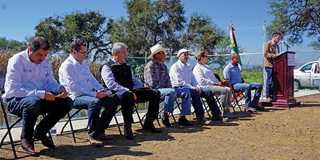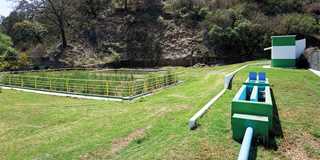The Human Component of Conservation
Ducks Unlimited de México, Axalta Coating Systems, and many other partners are working with local communities to conserve wetlands and improve lives in the Lake Cuitzeo watershed
Ducks Unlimited de México, Axalta Coating Systems, and many other partners are working with local communities to conserve wetlands and improve lives in the Lake Cuitzeo watershed
By Jennifer Boudart
Every autumn, an estimated 25 percent of North Americas waterfowl migrate to Mexico. In fact, of the more than 30 species of waterfowl that occur in Mexico, most are seasonal visitors. During these birds winter sojourn, access to high-quality habitat is crucial because it impacts other aspects of their life cycles. These birds must acquire the nutrients they need to make the long trip back north to their breeding grounds, explains Craig LeSchack, DUs director of conservation operations. LeSchack describes it as the continental connection.
Ducks Unlimited has long understood this connection. Ducks Unlimited de Mxico (DUMAC) was founded in 1974 to focus on conserving that nations most important waterfowl wintering habitats. As part of its Wetlands Inventory Program, DUMAC has identified 10.5 million acres of wetlands in three priority regions for waterfowl across the country. These wetland systems are diverse, ranging from coastal lagoons and mangrove swamps to inland freshwater lakes and seasonal wetlands. Collectively, they support 84 percent of waterfowl that overwinter in Mexico.
LeSchack says wetlands conservation in Mexico offers unique challenges and opportunities. Conservation is a high priority in the country but resources are limited. In Mexico, theres an opportunity to work toward the goal of protecting wetlands not just for wildlife but also for the benefit of local communities, LeSchack notes.
DUMACs Lake Cuitzeo project, located in the state of Michoacan, is a good example. Roughly 100,000 acres, Lake Cuitzeo is Mexicos second-largest natural freshwater wetland. It provides crucial wintering and stopover habitat for waterfowl, including northern pintails, northern shovelers, American wigeon, blue-winged teal, cinnamon teal, and canvasbacks. It also provides year-round habitat for the Mexican duck and is an important area for shorebirds and geese.

Ducks Unlimited de Mxico, along with representatives from Axalta Coating Systems and other partners, gathered to dedicate two wastewater treatment plants near Lake Cuitzeo. Mayors from each community signed agreements to operate the plants using municipal funding.
Photo Ducks Unlimited de Mexico
The main threat to Lake Cuitzeo is declining water quality due to poor land-use practices. Thousands of people live throughout the lakes 9.9-million-acre watershed, mainly in rural communities. Soil erosion associated with expanding settlements, uncontrolled timber harvesting, and urban development has increased sedimentation of the lake. Agricultural runoff and untreated human wastewater also wash into the lake, causing increased bacteria levels, reduced oxygen levels, and the spread of invasive plants. These conditions degrade waterfowl habitats and also jeopardize human health and economic activities such as fishing.
In 2010, DUMAC began assessing what CEO and Executive Director Eduardo Carrera calls the human component of conservation at Lake Cuitzeo. We realized that land-use practices in the upper part of the watershed were affecting the lower part of the watershed, where the lake is located, Carrera recalls. We knew we could not be effective by just working in the wetland. DUMAC held workshops with local, state, and federal authorities to develop its first-ever watershed-based management plan. The plans goals include not only restoring wetland habitat but also improving the quality of life for surrounding communities.
For example, improving sanitation is one major goal. We coordinate with the National Water Commission and focus on communities that are too small to receive government funds for sewage treatment systems and drinking water, Carrera explains. To date, DUMAC has overseen construction of eight wastewater treatment plants that serve 6,300 residents. In addition, DUMAC has installed 500 ecofriendly toilets at no cost for nearly 2,000 residents. These include biodigester toilets, which are installed in homes that have indoor toilets but where flushed water simply flows outside the house. These systems use bacteria to clean flushed water by digesting organic material. Dry toilets are provided to residents who lack running water and use outdoor facilities. Often, these toilets not only improve sanitation but also give people greater security, privacy, and dignity.
DUMAC also delivers free workshops that teach farmers sustainable methods for agriculture. These are not rich people with huge areas dedicated to agriculture, says Gabriela de la Fuente, assistant director of DUMAC. They may be working with horses or cultivating the soil by hand. DUMAC partners with Chapingo Autonomous University to deliver these workshops, which feature techniques and products that are more sustainable to useand typically less expensive.
Raising awareness about wetlands conservation is another goal, as people who live far from wetland areas often dont understand how their activities impact these ecosystems. In conjunction with the University of Guadalajara, DUMAC developed Teaching the Teachers, a curriculum that trains elementary, secondary, and high school teachers to incorporate environmental education into their classrooms. More than 2,000 teachers have attended these free workshops to date. DUMAC is also developing a childrens workbook called Wetlands ABC.

Photo Ducks Unlimited de Mexico
According to de la Fuente, the Lake Cuitzeo project has brought together more partners than any other projectincluding federal, state, and municipal authorities; universities; nongovernmental organizations; foundations; private donors; and international corporations. One vital corporate partner is Axalta Coating Systems, which entered a multiyear, multimillion-dollar partnership with Ducks Unlimited in 2015 for conservation projects throughout North America.
Axalta Mexico provides major funding for DUMACs sanitation initiatives, including construction of two wastewater treatment plants that began operating in key communities in Michoacan in late 2018. Axalta also helps fund educational initiatives such as the Teaching the Teachers workshops. Axalta and DU are both global organizations with a passion for environmental stewardship, preservation, and teamwork, says Daniel Salcido, president of Axalta Mexico. Im very proud to be a part of this collaboration to protect waterfowl and provide clean and healthy wetlands.
Lake Cuitzeo also represents the first DUMAC project to involve a watershed-based approach. Due to its scope, theres still much work to be done; Carrera estimates the project could last 10 more years. Even so, there is much to celebrate. Water quality has dramatically improved in areas with better sanitation, and issues such as eye, skin, and stomach irritation are less common. Work has been completed to restore and enhance wetland areas within the lake and to stabilize lake levels. Reforestation is reducing soil erosion. Workshops for farmers and teachers are in high demand, and residents have even participated in wetland restoration work.
Now people understand that while were interested in the lake because of the waterfowl, our work in turn helps many, many people, de la Fuente says. They have come to really trust us, because theyve seen that when we say were going to do something, we really do it.
Ducks Unlimited uses cookies to enhance your browsing experience, optimize site functionality, analyze traffic, and deliver personalized advertising through third parties. By continuing to use this site, you agree to our use of cookies. View Privacy Policy